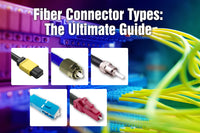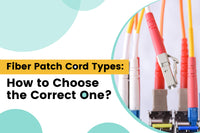Contents
In fiber optic networks, the signal needs to be amplified to reduce attenuation and improve data transmission over long distances. However, under certain circumstances, excessive optical power can saturate fiber receivers, resulting in high error rates and potential damage to network devices. An attenuator in optical fiber serves to control the signal power in the link. This article provides a comprehensive introduction to the attenuator in optical fiber.
What is an Attenuator in Optical Fiber?
In fiber optic communication systems, excessive optical signals may occur due to mismatched transmitters and receivers, improper amplification, or the use of media converters not suited for the transmission range. That’s why you need a fiber attenuator to avoid signal distortion and achieve optimal performance.
An attenuator in optical fiber, known as a fiber optic attenuator or optical attenuator, is a passive component to reduce the level of signal through a specific mechanism and achieve an appropriate signal power level in the fiber transmission link. It works at a certain wavelength to attenuate light and reduce reflection. The fiber optic attenuator is usually used to test the fiber optic power level or to balance the optical signal level of the transmitter and receiver.
Fiber optic attenuators are typically used with optical receivers and fiber connectors. In single-mode fiber transmission, fiber optic attenuators are essential to keep optical power balanced during the transmission. Conversely, the power in multimode systems is usually insufficient to saturate the receivers.
How Does a Fiber Optic Attenuator Work?
Fiber optic attenuators use a range of methods to reduce the power level, such as diffusion, scattering, diffraction, absorption, reflection, etc. Some fiber optic attenuators achieve the function by leaving a certain air gap between two fibers, causing signal loss as light traverses the gap. Attenuators can also use scattering techniques to deliberately scatter optical signals to decrease their intensity and achieve the desired attenuation. Some fiber attenuators use special materials to absorb optical energy and convert it to heat, thereby reducing the power level.
Different fiber optic attenuators vary in their performance characteristics, such as return loss, attenuation accuracy, wavelength dependence, temperature control, mode adaptability, and so on. Therefore, it is necessary to select optical attenuators according to specific applications.
Fiber Attenuator Types
Fiber optic attenuators come in various types based on different factors, including attenuation adjustability, mechanism, fiber mode, form factors, and designs. Here are the detailed types of fiber optic attenuators.
Based on Attenuation Adjustability
- Fixed Optical Attenuators (FOA)
Fixed optical attenuators are designed to provide fixed attenuation values, such as 5 dB, 10 dB, and 20 dB. These optical attenuators can be combined to attain the desired attenuation value. Fixed optical attenuators are well suited to permanently reduce the signal power to an ideal level in single-mode systems.
- Variable Optical Attenuators (VOA)
Variable optical attenuators allow for adjusting attenuation values. Variable optical attenuators can be classified into stepwise and continuously variable types. For example, a step variable attenuator allows you to increase or decrease the attenuation value by 0.5 dB per step. In contrast, continuously variable attenuators have flexible adjustment, so their attenuation levels can be more precise. These optical attenuators are particularly helpful in applications where input power or output requirements change frequently. They are widely used in testing and measurement.
Based on Fiber Types
Although most fiber optic attenuators are designed for single-mode fibers, some are also designed for multimode fibers. Fiber attenuators can be divided into single-mode and multimode fiber attenuators. Single-mode fiber attenuators are commonly used in long-distance signal transmission and short-circuit transmissions where there is a risk of optical power saturation. For attenuators in multimode fibers, factors such as the working principles and wavelengths need to be taken into account.
Based on Form Factors
Fiber optic attenuators are divided into three categories based on their form factors: connector, adapter, and in-line types. The connector type is the most common type of fixed optical attenuator. These fiber attenuators are male-to-female units made in the same form factor as fiber optic connectors, available in various kinds such as SC, ST, FC, MU, MPO, E2000, LC attenuators, etc. They can be installed at one end of a fiber optic cable and connected to a receiving device or panel.
The adapter-type fiber attenuator is a female-to-female unit used to connect two fibers, and the in-line fiber attenuator is integrated into a fiber patch cable. These two types of attenuators can be either fixed or variable optical attenuators.

How to Choose the Correct Fiber Optic Attenuator?
Selecting the right fiber attenuator involves several key considerations. Here is an overview of some crucial factors.
- Attenuation Value: Fiber attenuators come with varying attenuation values. You should choose the right attenuator with an attenuation value that fits the specific needs of your application. Select a variable attenuator if you need adjustable attenuation values.
- Return Loss & Insertion Loss: Ensure that the fiber optic attenuator has a proper return loss to keep signal integrity. In some applications, however, fiber attenuators with particularly high return losses are required to avoid issues like parasitic lasers. You should also consider the insertion loss of the fiber attenuator to ensure that it does not cause excessive signal loss.
- Operating Wavelength: Some fiber optic attenuators are wavelength-dependent and have different attenuation levels for various wavelengths such as 850nm, 1310nm, and 1550nm. You should ensure that the fiber attenuator is compatible with the specific wavelength used in your system.
- Fiber Type: Select the fiber attenuator designed for the type of fibers you are using - single-mode or multimode fibers.
- Fiber Connector & Polish Type: Make sure that the fiber optic attenuator matches the connector type and polish type of the fiber. Common fiber connector types include LC, SC, ST, FC, MTP, etc, and polish types include APC, PC, and UPC.
- Environmental Conditions: Consider the operating temperature and the fiber attenuators’ resistance to humidity and dust. These factors are especially essential if the attenuator is used in harsh environments.
- Budget: Variable optical attenuators are usually more expensive than fixed optical attenuators. When making your final decision, balance your needs, the required level of flexibility and precision, and your budget.
Fiber Attenuator Applications
Fiber attenuators are widely used in the optical field, whether in fiber-optic communication networks, CATV, DWDM systems, or high-power optical device tests and evaluations.
- In optical communications, fiber attenuators are needed to reduce power in order to avoid optical receiver overload, minimize signal distortion, and protect sensitive equipment from damage due to excessive optical power. Fiber attenuators are especially important for high-power and DWDM systems.
- In fiber systems with multiple wavelength channels, fiber attenuators are used to balance signals between multiple paths and channels.
- Fiber attenuators can be used in field testing to measure the performance, response, and accuracy of fiber optic systems. It is also used in system simulation to evaluate the level of attenuation in real conditions.
Final Words
Optical attenuators play an important role in fiber optic systems, providing precise control of optical signal intensity. To take full advantage of fiber optic attenuators, it is necessary to have a thorough understanding of their types, how they work, and how to make an informed choice. Hopefully, this article will help you to choose the most suitable fiber attenuator.
For more information on this topic, you can keep up on our blogs. While VCELINK offers general and basic information for our customers and other visitors to the website, it’s not professional advice.



Be the first one to comment.
Leave a comment